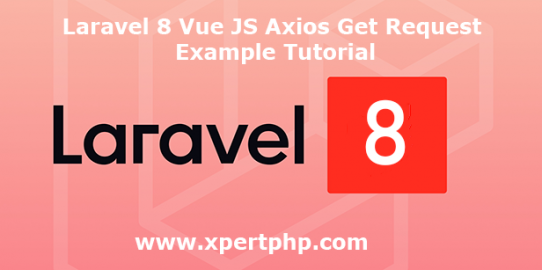In this article, we will guide you step by step on how to create laravel 8 Vue js Axios get a request example(Laravel 8 Vue JS Axios Get Request Example Tutorial). we will learn how to send an HTTP request using Axios in Vue js. we will fetch data from the server using the Vue js Axios to get a request.
The Axios is an HTTP client library. It allows you to send get, post, put, delete requests with a parameter, Formdata, headers, string, image, multipart / form-data, etc. The Axios library is an amazing library for HTTP requests.
In this example, we will give you a simple example of Vue JS Axios Get Request. so you can see the following steps.
Overview
Step 1: Install Laravel 8
Step 2: Setting Database Configuration
Step 3: Create Routes
Step 4: Create Controller
Step 5: Install Vue Js dependency
Step 6: Create Component and update app.js
Step 7: Update Blade Files
Step 8: Run Our Laravel Application
Step 1: Install Laravel 8
We are going to install laravel 8, so first open the command prompt or terminal and go to xampp htdocs folder directory using the command prompt. after then run the below command for laravel 8 install.
1 | composer create-project --prefer-dist laravel/laravel laravel8_vue |
Step 2: Setting Database Configuration
After the complete installation of laravel. we have to database configuration. now we will open the .env file and change the database name, username, password in the .env file. See below changes in a .env file.
1 2 3 4 5 6 | DB_CONNECTION=mysql DB_HOST=127.0.0.1 DB_PORT=3306 DB_DATABASE=Enter_Your_Database_Name(laravel8_vue) DB_USERNAME=Enter_Your_Database_Username(root) DB_PASSWORD=Enter_Your_Database_Password(root) |
Step 3: Create Routes
Add the following route code in the “routes/web.php” file.
1 2 3 | use App\Http\Controllers\UserController; Route::get('users', [UserController::class, 'index']); |
Step 4: Create Controller
Here below command help to create the controller and model.
1 | php artisan make:controller UserController |
UserController.php
1 2 3 4 5 6 7 8 9 10 11 12 13 14 15 16 17 18 19 20 21 22 23 24 25 26 27 | <?php namespace App\Http\Controllers; use Illuminate\Http\Request; use Symfony\Component\HttpFoundation\Response; use App\Models\User; class UserController extends Controller { /** * Display a listing of the resource. * * @return \Illuminate\Http\Response */ public function index() { return response()->json([ 'users' => \App\User::latest()->get() ], Response::HTTP_OK); } } ?> |
Step 5: Install Vue Js dependency
in this step, go to the project directory using the command prompt. after then run the below command for Install Vue Js dependency.
1 | npm install |
Step 6: Create Component and update app.js
resources/js/components/UserComponent.vue
1 2 3 4 5 6 7 8 9 10 11 12 13 14 15 16 17 18 19 20 21 22 23 24 25 26 27 28 29 30 31 32 33 34 35 36 37 38 39 40 41 42 43 44 45 | <template> <div class="container"> <div class="row justify-content-center"> <div class="col-md-12"> <div class="card"> <div class="card-header">User List</div> <div class="card-body"> <table> <tr> <th width="50%">Name</th> <th width="50%">Email</th> </tr> <tr v-for="user in users" :key="user.id"> <td>{{ user.name }}</td> <td>{{ user.email }}</td> </tr> </table> </div> </div> </div> </div> </div> </template> <script> export default { data() { return { users: {}, } }, methods: { getUser(){ axios.get('/users') .then((response)=>{ this.users = response.data.users }) } }, created() { this.getUser() } } </script> |
resources/js/app.js
1 2 3 4 5 6 7 | require('./bootstrap'); window.Vue = require('vue'); Vue.component('user-component', require('./components/UserComponent.vue').default); const app = new Vue({ el: '#app', }); |
Step 7: Update Blade Files
So finally, first we need to Update the welcome.blade.php file in the “resources/views/” directory and update the below code.
welcome.blade.php
1 2 3 | <div class="card-body"> <user-component></user-component> </div> |
Step 8: Run Our Laravel Application
We can start the server and run this example using the below command.
1 2 3 | npm run dev //or npm run watch |
Now we will run our example using the below Url in the browser.
1 | http://127.0.0.1:8000/ |
